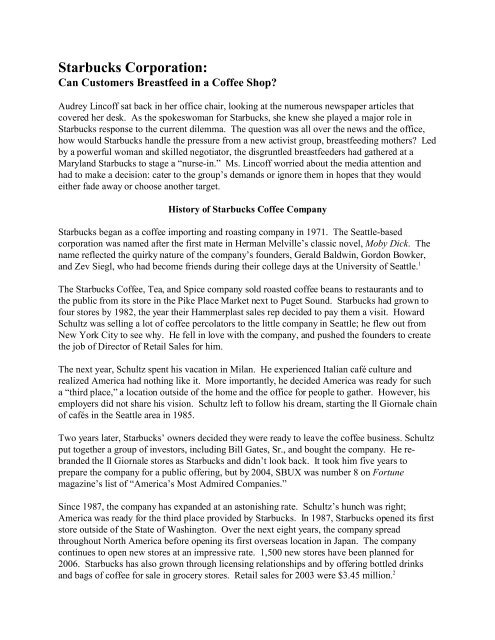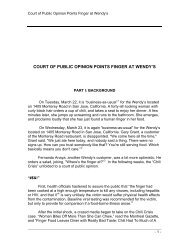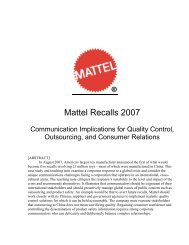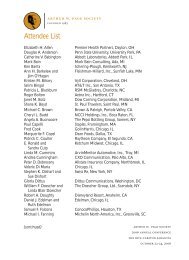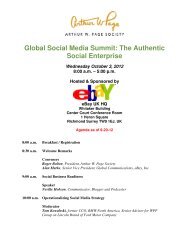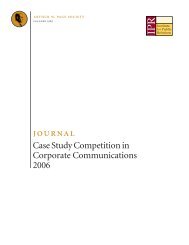Starbucks Corporation: - The Arthur Page Society
Starbucks Corporation: - The Arthur Page Society
Starbucks Corporation: - The Arthur Page Society
Create successful ePaper yourself
Turn your PDF publications into a flip-book with our unique Google optimized e-Paper software.
<strong>Starbucks</strong> <strong>Corporation</strong>:<br />
Can Customers Breastfeed in a Coffee Shop?<br />
Audrey Lincoff sat back in her office chair, looking at the numerous newspaper articles that<br />
covered her desk. As the spokeswoman for <strong>Starbucks</strong>, she knew she played a major role in<br />
<strong>Starbucks</strong> response to the current dilemma. <strong>The</strong> question was all over the news and the office,<br />
how would <strong>Starbucks</strong> handle the pressure from a new activist group, breastfeeding mothers? Led<br />
by a powerful woman and skilled negotiator, the disgruntled breastfeeders had gathered at a<br />
Maryland <strong>Starbucks</strong> to stage a “nurse-in.” Ms. Lincoff worried about the media attention and<br />
had to make a decision: cater to the group’s demands or ignore them in hopes that they would<br />
either fade away or choose another target.<br />
History of <strong>Starbucks</strong> Coffee Company<br />
<strong>Starbucks</strong> began as a coffee importing and roasting company in 1971. <strong>The</strong> Seattle-based<br />
corporation was named after the first mate in Herman Melville’s classic novel, Moby Dick. <strong>The</strong><br />
name reflected the quirky nature of the company’s founders, Gerald Baldwin, Gordon Bowker,<br />
and Zev Siegl, who had become friends during their college days at the University of Seattle. 1<br />
<strong>The</strong> <strong>Starbucks</strong> Coffee, Tea, and Spice company sold roasted coffee beans to restaurants and to<br />
the public from its store in the Pike Place Market next to Puget Sound. <strong>Starbucks</strong> had grown to<br />
four stores by 1982, the year their Hammerplast sales rep decided to pay them a visit. Howard<br />
Schultz was selling a lot of coffee percolators to the little company in Seattle; he flew out from<br />
New York City to see why. He fell in love with the company, and pushed the founders to create<br />
the job of Director of Retail Sales for him.<br />
<strong>The</strong> next year, Schultz spent his vacation in Milan. He experienced Italian café culture and<br />
realized America had nothing like it. More importantly, he decided America was ready for such<br />
a “third place,” a location outside of the home and the office for people to gather. However, his<br />
employers did not share his vision. Schultz left to follow his dream, starting the Il Giornale chain<br />
of cafés in the Seattle area in 1985.<br />
Two years later, <strong>Starbucks</strong>’ owners decided they were ready to leave the coffee business. Schultz<br />
put together a group of investors, including Bill Gates, Sr., and bought the company. He rebranded<br />
the Il Giornale stores as <strong>Starbucks</strong> and didn’t look back. It took him five years to<br />
prepare the company for a public offering, but by 2004, SBUX was number 8 on Fortune<br />
magazine’s list of “America’s Most Admired Companies.”<br />
Since 1987, the company has expanded at an astonishing rate. Schultz’s hunch was right;<br />
America was ready for the third place provided by <strong>Starbucks</strong>. In 1987, <strong>Starbucks</strong> opened its first<br />
store outside of the State of Washington. Over the next eight years, the company spread<br />
throughout North America before opening its first overseas location in Japan. <strong>The</strong> company<br />
continues to open new stores at an impressive rate. 1,500 new stores have been planned for<br />
2006. <strong>Starbucks</strong> has also grown through licensing relationships and by offering bottled drinks<br />
and bags of coffee for sale in grocery stores. Retail sales for 2003 were $3.45 million. 2
Corporate Culture<br />
<strong>Starbucks</strong>’ unique culture was what led Howard Schultz to leave his successful appliance sales<br />
career and move his family from one coast of the country to the other. As it has grown, the<br />
leadership has been careful to maintain and grow the company’s culture. As Schultz has said,<br />
“Building <strong>Starbucks</strong> has been very much about building the company my father never got a<br />
chance to work for.” 3<br />
All <strong>Starbucks</strong>’ employees who work more than 20 hours per week are eligible for benefits. <strong>The</strong><br />
company also works with the farmers who grow the coffee beans to improve their lives, as coffee<br />
growing regions tend to be very poor and the cost of coffee has been depressed because of<br />
oversupply. 4 <strong>Starbucks</strong>’ baristas tend to be proud of both the company they work for and the<br />
training they receive. Upper management is more diverse than most large companies in the<br />
United States. 5 All of this has built the company’s reputation for being progressive, even liberal,<br />
for a large corporation.<br />
Training<br />
Barista training involves 20 hours of on-line and in-store on-the-job training. Many of the stores<br />
have wireless internet routers. While the wi-fi connection is a great draw for customers, it also<br />
complements the company’s training program. After entry-level training, advanced programs are<br />
also available on-line, including the recently introduced “black apron” training for baristas to<br />
achieve Coffee Master status. 6<br />
<strong>The</strong> management training program involves another ten weeks. 7 <strong>Starbucks</strong> knows that an<br />
important part of developing superior managers is making sure the right people go through the<br />
training program. Training for store development managers is conducted at headquarters in<br />
Seattle after the managers have worked for at least three months in a store. 8<br />
Customers<br />
While employees clearly come first in the <strong>Starbucks</strong> culture, the customer is a close second.<br />
<strong>Starbucks</strong>’ fourth guiding principle is to “Develop enthusiastically satisfied customers all the<br />
time.” “We recognized early on that the equity of the <strong>Starbucks</strong> brand was going to be the retail<br />
experience that the customers had in our stores,” says Schultz. 9<br />
As an industry analyst recently noted, “<strong>The</strong> two things that make them great are real estate and<br />
making sure no one has a bad experience in their stores.” Schultz says this is because “our<br />
customers see themselves inside our company, inside our brand – because they’re part of the<br />
<strong>Starbucks</strong> experience.” 10<br />
2
<strong>The</strong> Breastfeeding Protest: Got Milk?<br />
On August 8, 2004 a new item was added to a Maryland <strong>Starbucks</strong> menu, but for a much younger<br />
crowd. About 100 people, including babies, the babies’ mothers and fathers, grandmothers and<br />
friends, filed into a Silver Springs, Maryland <strong>Starbucks</strong> coffee shop to stage a “nurse-in.”<br />
Holding signs, feeding babies, and passing out fliers on the benefits of breastfeeding, the mothers<br />
were focused.<br />
<strong>The</strong> idea of the “nurse-in” began a month earlier, after a <strong>Starbucks</strong>’ employee received several<br />
complaints and asked Lorig Charkoudian to relocate to the bathroom or cover up as she breastfed<br />
her 15-month-old daughter in the Maryland coffee shop. Inspired by the incident, Lorig gathered<br />
about 30 mothers to breastfeed at the store and protest actions that they felt belittled the<br />
importance of breastfeeding, which they saw as a natural, healthy process. Lorig argued that<br />
covering is uncomfortable for the baby and that breastfeeding shows, in her words, “fewer<br />
breasts than the average beer ad.” 11<br />
By 2005, <strong>Starbucks</strong> did not have an official policy regarding breastfeeding in its coffee shops. In<br />
Lorig’s case, the law was on her side. In Maryland, an Act passed in 2003 prohibits stopping<br />
mothers from breastfeeding in public. <strong>Starbucks</strong> spokeswoman, Audrey Lincoff, responded by<br />
stating that “<strong>Starbucks</strong> complies with all applicable state and local laws regarding breastfeeding”<br />
and that <strong>Starbucks</strong> would “instruct our Maryland store partners to inform any concerned<br />
customer that by Maryland law, mothers have their right to breastfeed in pubic and to suggest to<br />
the customer that they either avert their eyes or move to a different location within the store.” 12<br />
Unfortunately for <strong>Starbucks</strong>, Lorig was not satisfied with this effort. She wanted <strong>Starbucks</strong> to<br />
allow breastfeeding in all of its 5,882 United States shops. To support her efforts, Lorig started a<br />
website, http://www.nurseatstarbucks.com, to allow mothers to send letters to <strong>Starbucks</strong> chief<br />
executive, Orin C. Smith. 13 “It’s all about public acceptance of breastfeeding,” said Lorig. 14<br />
Supporting mothers seemed to agree with the decision to use <strong>Starbucks</strong> for their demonstrations.<br />
One participating “nurse-in” mother responded by saying, “If you look at the clientele during<br />
business hours, you’ll find a lot of young mothers with children who come to congregate and<br />
talk. If they want to continue to attract this clientele, they need to change their policies.” 15 On<br />
the other hand, a regular, loyal customer inside the shop at the time of the demonstration<br />
responded by stating that Lori’s decision was an “overreaction” and that in a place where he is<br />
eating or drinking, a “nurse-in” was the last thing he wanted to see. 16<br />
<strong>The</strong> Leader of the Pack<br />
Lorig Charkoudian is no stranger to public confrontation and conflict. From the death penalty to<br />
elephant rights, she has been involved in a number of causes and movements. Recently voted<br />
one of “Maryland’s Top 100 Women,” Charkoudian has a history of public confrontation and<br />
public demonstrations.<br />
3
From 1995 to 2005, Charkoudian served as the founder and executive director of the Community<br />
Mediation Program (CMP) in Baltimore. <strong>The</strong> CMP was established initially to help Baltimore<br />
residents resolve conflicts non-violently, but developed into a much larger program spanning the<br />
State of Maryland. She is also employed as an adjunct professor in the University of Baltimore’s<br />
Negotiation and Conflict Management Program. Charkoudian is the recipient of numerous of<br />
local awards in the Baltimore area, including the Unsung Hero Award (1999), the Brick Award<br />
(1997), and the Human Rights Community Builder (1997). 17 Thus, it would appear the<br />
breastfeeding conflict at <strong>Starbucks</strong> is not the product of amateur activists; it is led by an<br />
experienced professional who knows how to lead and convince others to follow.<br />
Past Problems<br />
<strong>The</strong> breastfeeding issue is not the first to involve conflict and controversy in a <strong>Starbucks</strong> store.<br />
In 1995, <strong>Starbucks</strong>’ Corporate Customer Relations Manager, Betsy Reese, became aware of<br />
several problems associated with an espresso machine purchased by a customer named Jeremy<br />
Dorosin. In just six weeks, the problem had escalated to a point unforeseen by any <strong>Starbucks</strong><br />
executive.<br />
In April of 1995, Mr. Dorosin purchased an espresso machine from a California <strong>Starbucks</strong>, which<br />
left him unsatisfied because of defects. Upon returning the machine for repair, Dorosin received<br />
a “loaner”from the company. Apparently pleased with the performance of the machine he’d been<br />
loaned, Dorosin purchased another as a wedding gift for a friend. Unfortunately, his friend found<br />
the gift to be in unacceptable condition – dirty, wet, and not functioning properly – as if it had<br />
been previously used. Embarrassed, Dorosin returned the wedding gift to the <strong>Starbucks</strong> store and<br />
complained to the manager. After several interactions with the manager, the Corporate Service<br />
Supervisor, and the District Manager, no resolution could be reached. Even when <strong>Starbucks</strong><br />
offered apologies and gifts, Dorosin responded with “too little, too late.” In response, he chose<br />
to take the disagreement public and confront the company in the media. 18<br />
Jeremy Dorosin ran an advertisement in Wall Street Journal on May 5, 1995, describing what<br />
had happened to him and asking if other people had similar or comparable bad experiences with<br />
<strong>Starbucks</strong>. In response, he received thousands of calls from angry customers, competitors and<br />
employees. Although <strong>Starbucks</strong> and Dorosin’s stories differ concerning exactly when the<br />
company offered to apologize, one thing is crystal clear: the short timeline between problem and<br />
escalation. Between the first advertisement on May 5, 1995 until mid-June of that year, Dorosin<br />
received non-stop attention in four Wall Street Journal articles, three radio shows, three<br />
television program appearances, and one New York Times article. He even launched a website<br />
entitled, http://www.starbucked.com. 19 Dorosin’s name serves today as a reminder to <strong>Starbucks</strong><br />
of how small problems can escalate out of control.<br />
4
Breastfeeding Legislation<br />
On May 22, 2003, Maryland Governor Robert L. Ehrlich, Jr. signed legislation regarding<br />
breastfeeding in public. <strong>The</strong> State of Maryland Code, Title XX, Subtitle XIII states that:<br />
• A mother may breast-feed her child in any public or private location in which the<br />
mother and child are authorized to be.<br />
• A person may not restrict or limit the right of a mother to breast-feed her child. 20<br />
This law gives a mother the right to breast-feed her child virtually anywhere in the State of<br />
Maryland, but does not clarify whether or not an individual has the right to request that a mother<br />
cover her nipple during breast feeding.<br />
Maryland was not the first to enact legislation specifically governing breast feeding in public<br />
places. In fact, close examination of other state laws regarding breast feeding reveals the<br />
complexity of the situation. By 2005, sixteen U.S. states had no legislation exempting<br />
breastfeeding from indecent exposure laws. This leaves mothers who breastfeed in public at risk<br />
of violating a criminal statute.<br />
Some states, such as Missouri, give mothers the right to breast feed in public, but with as much<br />
discretion as possible. Georgia laws previously incorporated similar language, until 2002 when it<br />
was removed. Conversely, nine states have legislation stating, “a mother may breast feed her<br />
baby in any location, public or private, where the mother is otherwise authorized to be,<br />
irrespective of whether or not the nipple of the mother’s breast is covered during or incidental to<br />
the breast feeding.” New Jersey and Connecticut state laws impose a fine and even potential<br />
imprisonment for persons discriminating against breastfeeding mothers. State law in Hawaii and<br />
Illinois give breastfeeding mothers the right to bring proceedings against any person engaging in<br />
a discriminatory practice. Connecticut, Hawaii, and Louisiana refer to the restriction of the right<br />
of a mother to breast feed her child as a discriminatory practice. 21<br />
Not only do numerous state laws address public breastfeeding, but many states have enacted<br />
legislation regarding breastfeeding in the workplace, deferral of jury duty, and the exemption of<br />
sales and use tax on breastfeeding related items. Coincidently, Maryland was the first state to<br />
exempt breastfeeding supplies from sales tax. Considering that thirty-four states have some form<br />
of legislation regarding public breastfeeding, it was becoming obvious to <strong>Starbucks</strong> management<br />
that breastfeeding mothers had become a powerful special interest group.<br />
Breastfeeding Everywhere<br />
<strong>Starbucks</strong> is not the only organization attempting to assess the impact that a breastfeeding policy<br />
(or lack thereof) might have on company performance. McDonald’s experienced a similar<br />
incident as women across the country protested at local fast food restaurants in support of Jamie<br />
5
Lovett. Ms. Lovett was asked to stop nursing her 9-month-old at a McDonald’s in Birmingham,<br />
Alabama on June 27, 2004. <strong>The</strong> McDonald’s manager referred questions to marketing<br />
representative, Stacy Cox, who could not be reached for comment. 22<br />
Burger King also experienced a similar incident at a franchise in Salt Lake City. Burger King<br />
implemented a policy that allows breast-feeding in its restaurants the night before a scheduled<br />
protest. A spokesman for Burger King responded to the incident by saying, “We want to be a<br />
family-friendly place.” <strong>The</strong> new policy requires Burger King employees to ask complaining<br />
customers to move to a different area of the restaurant. While Burger King’s public apology and<br />
policy implementation satisfied the Utah woman, the same cannot be said for all breastfeeding<br />
advocates. Some women assert that a policy allowing breastfeeding is not enough. Advocates<br />
want restaurants claiming to be “family friendly” to provide a special room where mothers can<br />
breast feed their children. 23<br />
<strong>The</strong> array of responses from breastfeeding advocates makes it clear that satisfying all of their<br />
needs will be very difficult for any company. Any organization that succumbs to the demands of<br />
one breast feeding mother will open itself up to even more demands. Organizations must decide<br />
how far is too far and address this issue before it becomes a major crisis.<br />
Going Forward<br />
Ms. Lincoff swept the clippings into a folder to take to the communications strategy meeting.<br />
She wondered what shape the final plan would take. Even a small incident could damage the<br />
brand if it were mishandled. As she headed down the hall, she thought about the conflicting<br />
goals of the stakeholders and possible ways to satisfy them. With growth and success in the<br />
marketplace come challenges and opportunities of many sorts; breastfeeding mothers and their<br />
babies appeared to be next.<br />
Discussion Questions<br />
1. Should Lorig’s group’s demands be taken seriously, or are they just another case of<br />
ridiculous requests which can be safely ignored by the company?<br />
2. Is there a reasonable way for <strong>Starbucks</strong> to satisfy all customer segments?<br />
3. Assuming <strong>Starbucks</strong> adopts an official policy, how can it effectively communicate the<br />
policy throughout the company?<br />
4. When state laws which affect store operations change, how can <strong>Starbucks</strong> communicate<br />
the new laws to stores in that state to ensure that all stores are in compliance?<br />
6
Writing Assignment<br />
Please respond in writing to the issues presented in this case by preparing two documents: a<br />
communication strategy memo and a professional business letter.<br />
In preparing these documents, you may assume one of two roles: you may identify yourself as an<br />
external communication consultant who has been asked to provide Ms. Lincoff with advice, or<br />
you may identify yourself as a communication manager within <strong>Starbucks</strong> <strong>Corporation</strong>. Either<br />
way, you must prepare a strategy memo addressed to Ms. Audrey Lincoff, Vice President for<br />
Corporate Communication.<br />
Your strategy memo should provide analysis of the business problem, the relevant background<br />
details, critical issues, audience factors, options for action, and your specific recommendations.<br />
Think broadly and provide comprehensive advice for Ms. Lincoff regarding the issue of<br />
customers breastfeeding in <strong>Starbucks</strong> stores.<br />
You must also prepare a professional business letter for Howard Schultz’s signature. That<br />
document should be directed to <strong>Starbucks</strong> customers and should explain the company’s policy<br />
and the reasons why the company has adopted that policy. If you have questions about either of<br />
these documents, please consult your instructor.<br />
References<br />
1. Serwer, A. “Hot <strong>Starbucks</strong> to Go,” Fortune, 26 January 2004, 60.<br />
2. <strong>Starbucks</strong> corporate Website: http://www.starbucks.com. Retrieved 23 December 2004, 1:54<br />
p.m., est.<br />
3. O’Connell, P. “A Full-Bodied Talk with Mr. <strong>Starbucks</strong>,” BusinessWeek, 15 October 2004.<br />
Retrieved from http://yahoo.businessweek.com.<br />
4. Stopper, W. “Establishing and Maintaining the Trust of Your Employees,” Human Resource<br />
Planning. 21 June 2004.<br />
5. Fellner, K. “<strong>The</strong> <strong>Starbucks</strong> Paradox,” ColorLines, Spring 2004. Available from<br />
http://www.arc.org.<br />
6. Wolff, L. “Coffee Chains Perk Up Training, Store Design,” Gourmet News, 1 May 2004.<br />
7. Coeyman, M. “Loving the Daily Grind,” Restaurant Business, 10 October 1996, 82.<br />
8. H. D. “Boot Camp Brewhaha,” Training, 17 July 2004.<br />
9. Dann, Schultz, Somberg, and Levitan. “How to . . . Find a Hit as Big as <strong>Starbucks</strong>,” Business<br />
2.0, May 2004, 66.<br />
7
10. Smith, S. “Experiencing the Brand – Branding the Experience,” February 2001. Available<br />
from http://www.personaglobal.com.<br />
11. Helderman, R. “Maryland Moms Say No to Coverup at <strong>Starbucks</strong>,” Washington Post. 9<br />
August 2004. Available from: http://www.washingtonpost.com/ac2/wp-dyn/A50610.<br />
12. Mothers Stage ‘Nurse-in’ at <strong>Starbucks</strong> Store,” MSNBC. 10 August 2004. Available from<br />
http://www.msnbc.msn.com/id/5662809.<br />
13. Ibid.<br />
14. Charkoudian, L. Resume. Maryland Daily Record. 26 October 2004. Available from<br />
http://www.mddailyrecord.com/top100w/01charkoudian.html.<br />
15. Helderman, R. Washington Post. 9 August 2004.<br />
16. Ibid.<br />
17. Charkoudian, L. Maryland Daily Record. 26 October 2004.<br />
18. Rosenthal, D.; Barr, T.; and Boyd, T. “Dorosin v. <strong>Starbucks</strong>,” Case Research Journal.<br />
1998. Retrieved 2 October 2004 from http://www.starbucked.com.<br />
19. Ibid.<br />
20. “Maryland Code 20-81, S.B. 223, Chap. 369,” Maryland General Assembly Home <strong>Page</strong>. 22<br />
May 2003. Available from http://mlis.state.md.us/2003rs/chapters/Ch_369_SB0223T.rtf.<br />
21. Vance, M. “A Current Summary of Breastfeeding Legislation in the U.S.,” La Leche League<br />
International. 21 September 2004. Available from http://lalecheleague.org/Law/summary.html.<br />
22. Daley, J. “Local Breastfeeding Advocate to Join Nationwide Protest,” <strong>The</strong> Marion Star. 7<br />
August 2004. Available from http://www.marionstar.com/news/stories/20040807/localnews.<br />
23. “Breastfeeding OK at Burger King.” Online posting. A Sassy Lawyer in Phillipine<br />
Suburbia. 25 November 2003. Available from http://journal.houseonahill.net.<br />
8


